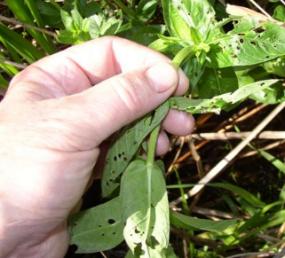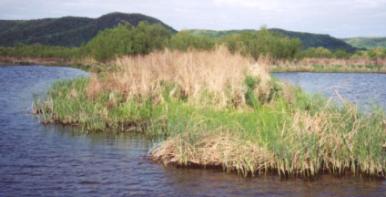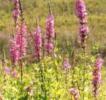Purple Loosestrife Control Project
Purple loosestrife (Lythrum salicaria) is a beautiful, but aggressive and invasive wetland plant that arrived in North America in the early 1800's. Plants were first brought to the United States by early settlers for their flower gardens, and the seeds were present in the ballast tanks of European ships that used soil to weigh down the vessels for stability on the ocean. Since it was first introduced, purple loosestrife has spread westward and can be found across much of Canada and the US.
Purple loosestrife is a very hardy perennial that can rapidly degrade wetlands, diminishing their value for wildlife habitat. When purple loosestrife gets a foothold, the habitat where fish and wildlife feed, seek cover, reproduce, and rear young quickly becomes choked under a sea of purple flowers. An estimated 190,000 hectares of wetlands, marshes, pastures, and riparian meadows are affected in North America each year, with an economic impact estimated in the millions of dollars. Biological control using plant-specific predators is a favored suppression method where hundreds of mature plants exist, or the infestation is spread over several acres such that digging and the use of herbicides may be impractical.

Since 2001, the BPCA has been rearing Galerucella spp. beetles at its insectary on Brice Prairie to be used for experimental biological control of purple loosestrife. The beetles have been released at selected sites around the Brice Prairie and Lake Onalaska area, in cooperation with the United States Fish and Wildlife Service (USFWS) and the Wisconsin Department of Natural Resources (WDNR).

Leaf damage from Galerucella spp.
Galerucella spp. beetles survive exclusively on purple loosestrife, feeding on bud, leaf, and stem tissue, resulting in defoliation, prevention of flowering/seed production, and eventual plant death. Following release of BPCA-reared beetles, purple loosestrife plant size and density decreases have occurred. Beetles are successfully reproducing and surviving at the release sites, and have been observed migrating across open water channels to new stands of loosestrife. An increase in BPCA beetle rearing capacity is planned for 2005.

2001 Galerucella spp. beetle release site, Mississippi River, pool 7
In autumn 2007, an informational sign was placed at the junction of County Highway Z and the bike trail about the loosestrife project and our success in controlling loosestrife in the Halfway Creek marsh. The La Crosse Tribune ran an article about the project when the sign was dedicated on November 15, 2007.
More information about purple loosestrife and Galerucella spp. beetles:
- Purple Loosestrife Fact Sheet (Wisconsin DNR)
- Purple Loosestrife Information (Minnesota DNR)
- Galerucella spp. Biology (UW Entomology Dept.)


 gmail.com
gmail.com